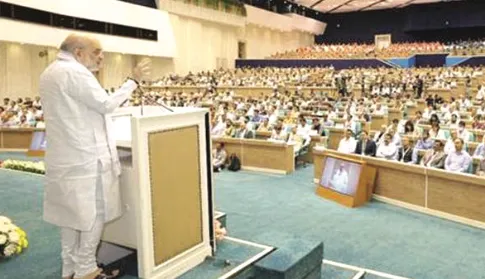New Delhi, Jun 16: Union Home Minister and Minister of Cooperation Amit Shah today addressed the annual conference of Relief Commissioners and Disaster Response Forces from States and Union Territories, underlining India’s transition from a relief-centric approach to a proactive and integrated disaster management framework over the past decade. Speaking as the chief guest at the event held in New Delhi, Shah was joined by Minister of State for Home Affairs Nityanand Rai, Union Home Secretary Govind Mohan, and other senior officials.
In his keynote address, Shah stressed that the government’s adoption of a “Whole of Government” approach has helped unify various disaster management agencies under one platform. Over the past two years, this integration has facilitated improved coordination and the formation of a think tank that has enhanced the country’s overall preparedness. “Multi-agency collaboration and a multi-stakeholder strategy have made our systems stronger and more efficient,” he said.
Citing the rising frequency and intensity of disasters due to climate change, Shah pointed to India’s emergence as a global leader in disaster risk reduction. He credited institutions such as the National Disaster Management Authority (NDMA), the National Disaster Response Force (NDRF), and the Coalition for Disaster Resilient Infrastructure (CDRI) for their contributions. He particularly lauded the NDMA for its work on policy development, training materials, digital tools, and coordination, and the NDRF for building nationwide credibility through rigorous training of both its own personnel and those of State Disaster Response Forces (SDRFs).
Amit Shah called the past 10 years under the Modi government a “transformative decade” in disaster response, marked by improvements in capacity, speed, efficiency, and accuracy. Disaster preparedness has been expanded down to the tehsil level, while forecasting and early warning systems have helped involve communities more effectively in relief and rescue efforts.
Highlighting a paradigm shift in India’s disaster management philosophy, Shah said the government has moved away from a purely relief-oriented strategy to one focused on “zero casualty.” He attributed the reduction in disaster-related fatalities to better forecasting, public participation, and inter-agency cooperation. Citing examples, he noted that while the 1999 super cyclone in Odisha killed around 10,000 people, Cyclone Fani in 2019 resulted in just one casualty, and Cyclone Biparjoy in Gujarat saw zero deaths—even among animals.
Financial empowerment has been a cornerstone of this strategy. According to Shah, the total disaster response budget increased from ₹66,000 crore (2004–2014) to ₹2 lakh crore (2014–2024). This includes an increase in the SDRF budget from ₹38,000 crore to ₹1.44 lakh crore, and the NDRF budget from ₹28,000 crore to ₹84,000 crore. For the first time, a ₹68,000 crore National Disaster Risk Management Fund has also been created.
Shah called on all Relief Commissioners to ensure that District Disaster Management Plans are finalized within the next 90 days. “Without such plans at the district level, a swift and effective disaster response is not possible,” he warned. He also emphasized the urgent need to roll out lightning-specific action plans and noted that many states have yet to implement the Incident Response System.
Modernization of fire services and localised action plans for heatwaves are also on the agenda. Shah highlighted NDMA’s issuance of 38 guidelines and 34 Standard Operating Procedures (SOPs), calling for their dissemination to the grassroots level.
Looking ahead, the Home Minister proposed making inter-state mock drills an annual event and integrating Start-up India into the development of disaster-response technology. He said the government is training one lakh community volunteers—20% of them women—under the Yuva Aapda Mitra (Young Disaster Friends) scheme, with an investment of ₹470 crore.
Shah also encouraged states to actively participate in the Subhash Chandra Bose Aapda Prabandhan Puraskar by sending nominations. He noted that the NDRF has doubled in size, from 8 battalions in 2006 to 16 now, and that the NDMA has begun night-time mock drills in sensitive areas like Leh-Ladakh. Successful cyclone mitigation projects in Odisha and Andhra Pradesh were cited as examples of effective risk reduction. “In the coming decade, our vision is to prepare every young Indian to be a disaster warrior—ready to respond with courage, training, and a spirit of service,” Shah concluded.








